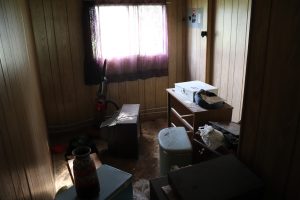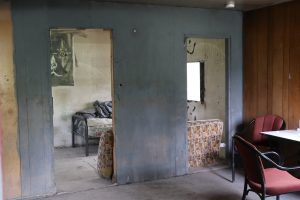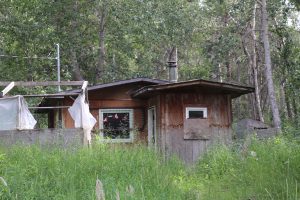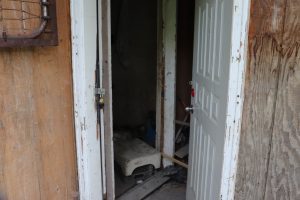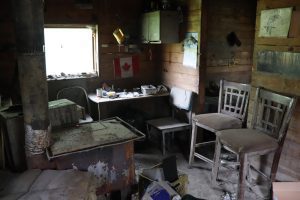Nestled behind trees and long grass are shacks and unfinished structures with no power or plumbing that house dozens of Fort Simpson residents.
This was the situation pre-flooding, an issue that has only gotten worse since.
In mid-July CKLB got a tour of around 10 homes that lack basic amenities and often house numerous residents who have fallen through the cracks of assistance programs for a variety of reasons.
Travis and Todd Minoza say their living situation is day-to-day.
“A couch here, a bed there,” explains Travis.
Both are from Tthets’ek’ehdeli (Jean Marie River) First Nation, but live in Fort Simpson because it has access to more — although limited — resources. However, those resources tend to be generosity from the community.
“Everybody knows us… They give us some work,” Todd says.
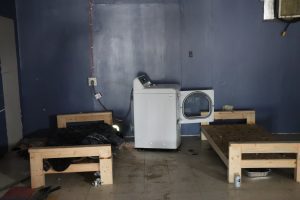
The inside of the shelter at the former Unity Store in Fort Simpson. The shelter was severely damaged by the flooding. (Photo by Luke Carroll/ CKLB.)
Community shelters
The community has taken a few steps to address the housing crisis.
This includes establishing a shelter in town last December, located at the old Unity Store location. The territorial government gave funding for the project.
The shelter had several beds, a fridge, an area to relax and bathrooms — but was forced to close in May.
“The actual flood came and the place got washed out,” said Fort Simpson Mayor Sean Whelly.
It’s currently in the process of being repaired, but that situation leaves residents like Todd and Travis on their own.
Since then members of the community have taken the situation into their own hands.
CKLB got a tour of a private residence that has been turned into an impromptu shelter. CKLB was unable to speak with the resident who opened the shelter, but Whelly says it’s someone who understands what the homeless population is dealing with.
There are several beds throughout the residence, a bathroom as well as a microwave and kettle for cooking.
Anyone in need can come and leave as they please, but there are rules for the residence including no drugs and alcohol allowed on-site.
Todd and Travis say unfortunately they are not allowed at this shelter.
“If you do anything crazy over there, he’ll get mad and just kick you out. We’re not allowed there no more,” Todd said.
Both Travis and Todd said they would like to get sober and if there were any programs in Fort Simpson, they would look to take part in it.
A complicated problem
Vera Deneyoua works as a chef, but despite being employed, she lives in a trailer with no plumbing and no electricity.
The trailer is in the back lot of a family home that she leaves open to those experiencing homelessness across the community.
During the winter, when temperatures dip to below -40, all she has is a small woodstove to keep her warm.
“I’ve been trying to get help from everybody. It’s seems like that they just won’t make an effort to help,” she says.
Deneyoua says she’s been in touch with the Lı́ı́dlı̨ı̨ Kų́ę́ First Nation (LKFN) band office for several years trying to get land to keep her trailer on, but there has been no progress.
Deneyoua says she likes her trailer and having a small space, but she wants to have the basic amenities to enjoy a normal standard of living.
“I want to actually have a shower and a toilet, and don’t have to worry every day about where I’m going to shower or go to the bathroom,” she says.
Then there is Allan Paul Anderson who is preparing to turn 70-years-old.
He also lives in a home with very few functioning amenities — he chops his own wood for warmth, but he says he has a history of heart attacks, and it’s becoming increasingly dangerous.
Anderson’s situation is complicated.
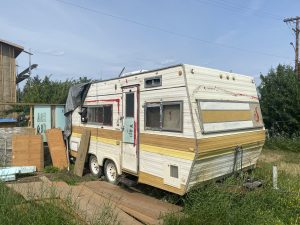
Vera Deneyoua lives in a trailer that relies on a woodstove for heat and has no basic plumbing or amenities. (Photo by Luke Carroll/ CKLB.)
From how he explains it, the land belongs to his family and he has lived there for decades and has no intention of leaving.
“This land here was nothing but muskeg and nightmare, look at it now,” he said. “If I wouldn’t have done the work I’ve done on this property, this property wouldn’t be worth a dime… But I’m getting tired now, I want to enjoy a little bit of my life.”
There is family drama and tax issues involved in the property, but having spent most of his life in the home, Anderson has no intention of leaving.
“Complicated situation, but despite that, there should be help available for him in some way that fits his needs,” Whelly says.
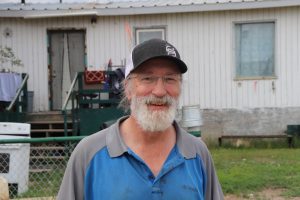
Fort Simpson Mayor Sean Whelly stands in front of one of the many houses in the community that are falling into disrepair. He says the community is experiencing a housing crisis and residents are living without basic amenities. (Photo by Luke Carroll/ CKLB.)
The solution?
Whelly says the situation in Fort Simpson is a full blown housing crisis.
Homes aren’t being built and there are numerous falling into disrepair, the owners don’t have enough money to repair.
Cara Bryant, the communications advisor for the NWT Housing Corporation (NWTHC), says in an email there are plans to build three market units — including a duplex and a single family — in Fort Simpson next summer.
Bryant says there are no available numbers for those experiencing homelessness in the territory, including Fort Simpson, but there are 25 people on the waiting list for public housing in Fort Simpson.
Whelly says building actual homes will help, something that hasn’t happened in the community for a longtime, but there also needs to be more programs, particularly flexible ones that meet the unique needs of the residents.
“A community housing committee made up of interested individuals that could assist in putting forth a plan,” he said. “We’ve made some steps in that direction by getting the shelter started.”
Whelly said a next step would be a women’s shelter and maybe mini homes to house some of those on the housing waitlist, but land is still an issue as there is a shortage in the community.
Whelly says the housing corporation’s current programs doesn’t meet the needs of the most needy.
There are issues around eligibility and paperwork, each of those interviewed in this story don’t meet the requirements for many of these programs. Either substance abuse, too high or low a salary or just an attachment to the land they live on prevent each of them the opportunity to qualify for available housing assistance.
But Whelly says they still deserve support.
“It’s not a simple solution, it has to be the whole community that wants to get this done,” he said. “Funding is a thing that is needed, but not necessarily more programs that don’t match what we need.”




